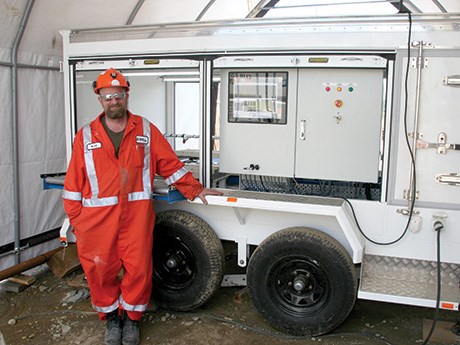Drill core analysis within hours instead of weeks
TruScan, an XRF technology developed by Boart Longyear and undergoing testing at the NORCAT Underground Centre north of Sudbury, is about to revolutionize mineral exploration.
Housed in a trailer that can be mobilized to a drill site, TruScan provides geologists with drill core analysis in hours.
“It also analyzes the drill core for every element between sodium and uranium on the periodic table simultaneously,” said Dr. Kirk Ross, Boart Longyear XRF engineer. “Normally, you’d have to ask for specific packages from the lab. Each lab package includes a certain number of elements, so you’d have to ask for several packages to get all the elements of interest. This could end up costing well over $100 per metre of core.
“Finally, TruScan can sample on any scale you desire – anything from a millimetre to a one-metre scale. A lab homogenizes a metre of core, takes a small representative sample of it, analyzes it and gives you the average composition over a metre. TruScan gives you the composition on any scale you want.”
Ross has put thousands of metres of drill core through the TruScan unit since it arrived in Sudbury in March, and the results, he said, are within one per cent of the results obtained from lab assays.
TruScan is designed to be operated by a driller. “There is no need for additional personnel,” said Ross. “You don’t need an XRF tech onsite. A box of core is loaded into the unit. A picture is taken, you tag the image and tell it what areas of the core are acceptable for analyzing. The box then moves into the second station where it undergoes XRF analysis.
When it’s done, the box is washed, another picture is taken and it’s ejected out the far side.”
Hand-held XRF technology has been around for several years, but the devices are poorly calibrated, said Ross.
“For every drill site we go to, we send a couple dozen rocks from the site away for chemical analysis. We get the chemistry back and we use that analysis to calibrate the XRF. The hand-held XRFs are not calibrated nearly as precisely. In fact, a lot of them use what’s called fundamental parameters, which is inaccurate to say the least.”
Near real-time results will allow mining and exploration companies to make quicker decisions.
“It gives the geologists the power to make immediate decisions to extend the hole, turn the hole to the right, or to the left,” said Lori Martin, Boart Longyear business development manager, geological data services. “It gives them a lot more in the moment control.”
Using TruScan, geologists can also look at trace, or pathfinder elements for clues to mineralization.
If one sample of quartz-rich core has economic gold values and another sample is barren, geologists can look at the pathfinder elements to determine if they’re “getting on to a hot zone, or not,” said Ross.
The trailer requires 110 or 220-volt power and an Internet connection to send data to Boart Longyear for QA/QC analysis.
The unit in Sudbury is on wheels, but is designed to accommodate skids and be dragged through the bush, or mobilized by helicopter to a remote drill site. The sensitive X-ray equipment would be removed and taken to the drill site separately.
Boart Longyear is in the final stages of testing TruScan and is currently looking for clients willing to participate in beta testing.
TruScan won’t eliminate assaying completely – at least in the near to medium term.
“It’s a progression and we’ll eventually get there,” said Martin. “Assaying will continue to be done in parallel, but TruScan will tell you exactly where you need to be doing assaying, instead of assaying the whole thing.”
The Boart Longyear R&D compound outside the NORCAT Underground Centre also includes an SC9 prototype drill rig used for testing the company’s latest tools.
The SC9 was designed for maximum safety and automation. Computer controlled, it features a rod handling system that minimizes manual interference.
“Typically, the driller and helper are right in there with their hands working on the rods, breaking them apart,” said site manager Sylvain Perreault. “This eliminates all that.”
Among the tools being tested at the site is TruCore, Boart Longyear’s core orientation tool. Already on the market but undergoing further testing, TruCore “tells the geologist the direction of the structure – for example, the joint sets, veins, alteration directions and the contacts between the different lithologies,” said Martin. “It’s important for building a 3D model.”
Boart Longyear announced its selection of Sudbury and the NORCAT Underground Centre as its North American R&D site in September 2016 at MINExpo in Las Vegas.



.jpg;w=120;h=80;mode=crop)